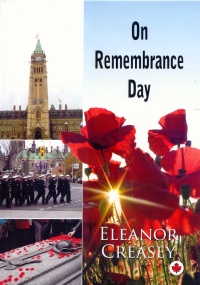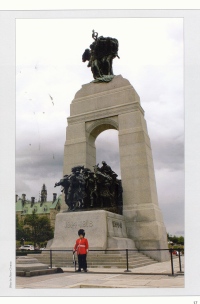| ________________
CM . . .
. Volume xxi Number 15 . . . . December 12, 2014

 |
On Remembrance Day.
Eleanor Creasey.
Toronto, ON: Dundurn, 2014.
40 pp., hc., PDF & ePub, $19.99 (hc.), $19.99 (PDF), $8.99 (ePub).
ISBN 978-1-4597-2166-1 (hc.), ISBN 978-1-4597-2167-8 (PDF) ISBN 978-1-4597-2168-5 (ePub).
Subject Heading:
Remembrance Day (Canada)-Juvenile literature.
Grades 4-7 / Ages 9-12.
Review by Tanya Boudreau.
*** /4
|

excerpt:
In Canada, we set aside one day each year, November 11, as Remembrance Day. The reason we observe Remembrance Day on this particular day is that it was on November 11, 1918, at 11:00 in the morning, that the armistice that ended the First World War came into effect. The armistice was an agreement between the Germans and the Allies to end the fighting. Later, a treaty was signed by all nations involved that set out the terms for peace.
The first Remembrance Day was observed a year after the armistice, on November 11, 1919. At the time it was called Armistice Day. The name was officially changed to “Remembrance Day” by a Canadian government bill passed in 1931.
 This notable book reminds us why Canadians honour Remembrance Day. It begins with a memorial, a photograph of The Tomb of the Unknown Soldier in Ottawa. The picture was taken at night, but the streetlights catch the brilliant red of the poppies that surround the tomb. On the following pages, one page descriptions provide information about the armistice agreement between the Germans and the Allies that ended the First World War, the inspiration for the poem “In Flanders Fields”, the stories about why we came to wear poppies, and Canada’s cenotaphs (war memorials). The author then details how Canadians pay tribute to the war dead (songs, laying wreaths, parades, silence), and provides notes on four other wars and peacekeeping operations in which Canada has been involved since World War One (Second World War, Korea, Kuwait, Afghanistan). The author focuses on one veteran’s story in particular (Gordon McKenzie Hill) and shows the gravestone of the first Canadian female to die in combat, Captain Nichola Goddard who was killed in Afghanistan. Children will be reminded of what it means to be a Canadian and why it’s important to show our Canadian pride after reading this book. The photographs are labelled and appear either as full page spreads or alongside a paragraph of text. The colour red from the poppies matches the red found in the chapter headings, subtitles and labels. Although there are no pictures of children in this book, they will recognize the poppy (shown with black centres, not the green centres), the Canadian flags, references to “O Canada”, and the various ceremonies mentioned in the book. I recommend school and public libraries purchase On Remembrance Day for their collections. This notable book reminds us why Canadians honour Remembrance Day. It begins with a memorial, a photograph of The Tomb of the Unknown Soldier in Ottawa. The picture was taken at night, but the streetlights catch the brilliant red of the poppies that surround the tomb. On the following pages, one page descriptions provide information about the armistice agreement between the Germans and the Allies that ended the First World War, the inspiration for the poem “In Flanders Fields”, the stories about why we came to wear poppies, and Canada’s cenotaphs (war memorials). The author then details how Canadians pay tribute to the war dead (songs, laying wreaths, parades, silence), and provides notes on four other wars and peacekeeping operations in which Canada has been involved since World War One (Second World War, Korea, Kuwait, Afghanistan). The author focuses on one veteran’s story in particular (Gordon McKenzie Hill) and shows the gravestone of the first Canadian female to die in combat, Captain Nichola Goddard who was killed in Afghanistan. Children will be reminded of what it means to be a Canadian and why it’s important to show our Canadian pride after reading this book. The photographs are labelled and appear either as full page spreads or alongside a paragraph of text. The colour red from the poppies matches the red found in the chapter headings, subtitles and labels. Although there are no pictures of children in this book, they will recognize the poppy (shown with black centres, not the green centres), the Canadian flags, references to “O Canada”, and the various ceremonies mentioned in the book. I recommend school and public libraries purchase On Remembrance Day for their collections.
Recommended.
Tanya Boudreau is a librarian at the Cold Lake Public Library in Cold Lake, AB.

To comment on this title or this review, send mail to cm@umanitoba.ca.
Copyright © the Manitoba Library Association. Reproduction for personal use is permitted only if this copyright notice is maintained. Any
other reproduction is prohibited without permission.
CM Home |
Next Review |
(Table of Contents for This Issue - December 15, 2014.)
| Back Issues | Search | CM Archive
| Profiles Archive
Updated: October 17, 2014 (hsd)
|

 This notable book reminds us why Canadians honour Remembrance Day. It begins with a memorial, a photograph of The Tomb of the Unknown Soldier in Ottawa. The picture was taken at night, but the streetlights catch the brilliant red of the poppies that surround the tomb. On the following pages, one page descriptions provide information about the armistice agreement between the Germans and the Allies that ended the First World War, the inspiration for the poem “In Flanders Fields”, the stories about why we came to wear poppies, and Canada’s cenotaphs (war memorials). The author then details how Canadians pay tribute to the war dead (songs, laying wreaths, parades, silence), and provides notes on four other wars and peacekeeping operations in which Canada has been involved since World War One (Second World War, Korea, Kuwait, Afghanistan). The author focuses on one veteran’s story in particular (Gordon McKenzie Hill) and shows the gravestone of the first Canadian female to die in combat, Captain Nichola Goddard who was killed in Afghanistan. Children will be reminded of what it means to be a Canadian and why it’s important to show our Canadian pride after reading this book. The photographs are labelled and appear either as full page spreads or alongside a paragraph of text. The colour red from the poppies matches the red found in the chapter headings, subtitles and labels. Although there are no pictures of children in this book, they will recognize the poppy (shown with black centres, not the green centres), the Canadian flags, references to “O Canada”, and the various ceremonies mentioned in the book. I recommend school and public libraries purchase On Remembrance Day for their collections.
This notable book reminds us why Canadians honour Remembrance Day. It begins with a memorial, a photograph of The Tomb of the Unknown Soldier in Ottawa. The picture was taken at night, but the streetlights catch the brilliant red of the poppies that surround the tomb. On the following pages, one page descriptions provide information about the armistice agreement between the Germans and the Allies that ended the First World War, the inspiration for the poem “In Flanders Fields”, the stories about why we came to wear poppies, and Canada’s cenotaphs (war memorials). The author then details how Canadians pay tribute to the war dead (songs, laying wreaths, parades, silence), and provides notes on four other wars and peacekeeping operations in which Canada has been involved since World War One (Second World War, Korea, Kuwait, Afghanistan). The author focuses on one veteran’s story in particular (Gordon McKenzie Hill) and shows the gravestone of the first Canadian female to die in combat, Captain Nichola Goddard who was killed in Afghanistan. Children will be reminded of what it means to be a Canadian and why it’s important to show our Canadian pride after reading this book. The photographs are labelled and appear either as full page spreads or alongside a paragraph of text. The colour red from the poppies matches the red found in the chapter headings, subtitles and labels. Although there are no pictures of children in this book, they will recognize the poppy (shown with black centres, not the green centres), the Canadian flags, references to “O Canada”, and the various ceremonies mentioned in the book. I recommend school and public libraries purchase On Remembrance Day for their collections.